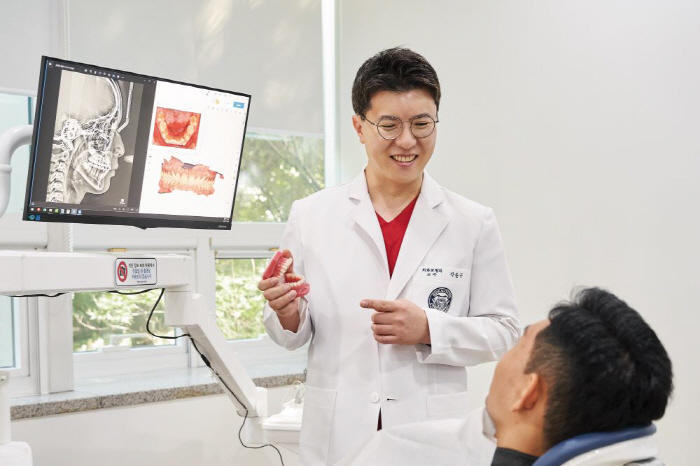What are the effects and drawbacks of fast orthodontic treatment that reduces the duration of long orthodontic treatment?
Apr 13, 2025
Orthodontic treatment is a typical dental treatment that takes a long time to treat. It can take months to years. The reason why orthodontic treatment takes a long time is that the remodeling of the gum bone, which is essential for moving the teeth, is slow. As the longer the treatment period, the greater the burden on patients, various methods have recently been proposed to shorten this. Professor Kang Yoon-gu of the Department of Orthodontics at Gangdong Kyunghee University Dental Hospital summarized rapid orthodontic treatment.
◇ Orthodontic treatment required for a long period of treatment
If there are functional and aesthetic problems due to improper dentition, consider orthodontic treatment. However, it is not easy to decide because the treatment period takes a long time from months to years. The longer treatment period is due to the very slow progression of the 'gum bone remodeling' itself required for tooth movement. 'Gum bone remodeling' refers to the entire process in which the absorption of the gum bone occurs in the direction in which the tooth moves and the formation of the gum bone occurs on the other side. In this process, the rate of absorption and formation of the gum bone determines the rate of tooth movement, and eventually affects the period of orthodontic treatment.
◇Growing children are faster than adults remodeling their gums
The rate of gum bone remodeling is usually faster in growing children than adults. This is why it is more recommended to have dental orthodontic treatment in growing up than in adulthood. Even in adulthood, the older you are, the slower you tend to be, so it takes longer to treat middle-aged than young people, older people than middle-aged people, and older people than older people. In addition, older people tend to have less gum bone formation, so more attention is needed.
◇'Drug, laser stimulation, surgery' to speed up teeth movement
Due to this principle of tooth movement, many researchers have been studying how to accelerate tooth movement since the past. The most representative methods are △ drug use, △ physical stimulation such as electricity or laser stimulation vibration stimulation, and △ direct surgery and procedures for the gum bone.
Various studies are being conducted to speed up the absorption and formation of gum bones using drugs.
Studies have shown that it is effective, but it is not used in actual treatment due to drug injection problems, drug persistence problems, and concerns about the drug's overall health. Although the method of using laser or vibration stimulation has also been applied in actual clinical practice, it is not yet widely used due to controversy over the effectiveness among researchers.
◇ Gum bone surgery and procedure most commonly used in clinical practice
The most tried and known effective method in clinical practice is surgery and procedure on the gum bone. When bone damage occurs, cells involved in bone formation and absorption gather quickly and in large numbers to the area to quickly heal it, speeding up bone remodeling.
It is to speed up the movement of teeth by utilizing the healing properties for such bone damage. In particular, it is effective for adults in the middle-aged, those with narrow gums, those with short teeth roots, and those who want to reduce the duration of orthodontic treatment. However, there are disadvantages such as burden of surgery and procedure, accompanying pain, and short effect duration.
◇Cutting or incision is performed on the gum bone cortical bone
Surgical and surgical procedures for gum bones include cortical bone amputation, which removes cortical bone, the hardest part of the bone, and cortical bone incision, which simply cuts the gum bone. If the gum bone is narrow, such surgery will be accompanied by treatment to expand the gum bone by adding bone graft materials.
As the scope of treatment expands, the effect increases, but the pain also increases. In addition, the ability to form bones varies with age, so the older the age, the more difficult the gum bone may not be made as much as the teeth have moved, especially if the gum bone is narrow. Therefore, it should be performed to safely move teeth and gum bones rather than simply to reduce the duration of treatment, and it must be decided how to operate and perform surgery through consultation with a dental orthodontist.
◇ Orthodontic treatment required for a long period of treatment
If there are functional and aesthetic problems due to improper dentition, consider orthodontic treatment. However, it is not easy to decide because the treatment period takes a long time from months to years. The longer treatment period is due to the very slow progression of the 'gum bone remodeling' itself required for tooth movement. 'Gum bone remodeling' refers to the entire process in which the absorption of the gum bone occurs in the direction in which the tooth moves and the formation of the gum bone occurs on the other side. In this process, the rate of absorption and formation of the gum bone determines the rate of tooth movement, and eventually affects the period of orthodontic treatment.
◇Growing children are faster than adults remodeling their gums
The rate of gum bone remodeling is usually faster in growing children than adults. This is why it is more recommended to have dental orthodontic treatment in growing up than in adulthood. Even in adulthood, the older you are, the slower you tend to be, so it takes longer to treat middle-aged than young people, older people than middle-aged people, and older people than older people. In addition, older people tend to have less gum bone formation, so more attention is needed.
◇'Drug, laser stimulation, surgery' to speed up teeth movement
Due to this principle of tooth movement, many researchers have been studying how to accelerate tooth movement since the past. The most representative methods are △ drug use, △ physical stimulation such as electricity or laser stimulation vibration stimulation, and △ direct surgery and procedures for the gum bone.
Various studies are being conducted to speed up the absorption and formation of gum bones using drugs.
Studies have shown that it is effective, but it is not used in actual treatment due to drug injection problems, drug persistence problems, and concerns about the drug's overall health. Although the method of using laser or vibration stimulation has also been applied in actual clinical practice, it is not yet widely used due to controversy over the effectiveness among researchers.
◇ Gum bone surgery and procedure most commonly used in clinical practice
The most tried and known effective method in clinical practice is surgery and procedure on the gum bone. When bone damage occurs, cells involved in bone formation and absorption gather quickly and in large numbers to the area to quickly heal it, speeding up bone remodeling.
It is to speed up the movement of teeth by utilizing the healing properties for such bone damage. In particular, it is effective for adults in the middle-aged, those with narrow gums, those with short teeth roots, and those who want to reduce the duration of orthodontic treatment. However, there are disadvantages such as burden of surgery and procedure, accompanying pain, and short effect duration.
◇Cutting or incision is performed on the gum bone cortical bone
Surgical and surgical procedures for gum bones include cortical bone amputation, which removes cortical bone, the hardest part of the bone, and cortical bone incision, which simply cuts the gum bone. If the gum bone is narrow, such surgery will be accompanied by treatment to expand the gum bone by adding bone graft materials.
As the scope of treatment expands, the effect increases, but the pain also increases. In addition, the ability to form bones varies with age, so the older the age, the more difficult the gum bone may not be made as much as the teeth have moved, especially if the gum bone is narrow. Therefore, it should be performed to safely move teeth and gum bones rather than simply to reduce the duration of treatment, and it must be decided how to operate and perform surgery through consultation with a dental orthodontist.
|
This article was translated by Naver AI translator.














